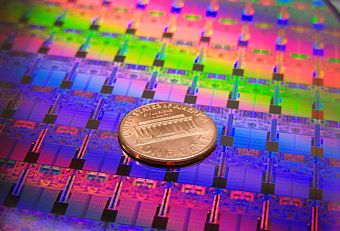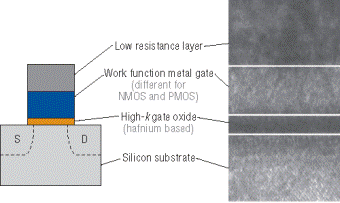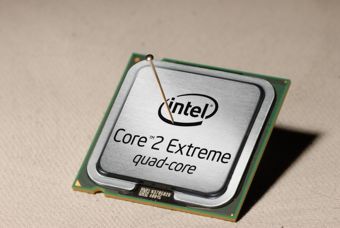
Con il comunicato stampa di seguito allegato, Intel ha annunciato sedici nuovi processori realizzati in
tecnologia a 45nm, collocati in parte nell'offerta per soluzioni server (Xeon) ed in parte in quella per PC
desktop di fascia high-end (Core 2 Extreme).
Sono essenzialmente due le motivazioni che rendono per certi versi storico il rilascio di queste cpu: la prima
riguarda proprio il processo produttivo a cui Intel è ricorsa per la costruzione dei chip che, essendo a 45nm,
li rende i primi in assoluto nelle rispettive categorie di appartenenza. Le nuove cpu sono capaci di contenere un numero di
transistor che è pari a circa due volte quello esibito dai processori della generazione precedente a 65nm. Un chip quad-core a 45 nm racchiude infatti 820 milioni di transistor.

La seconda, invece, risiede nell'architettura dei transistor ("formula") che costituiscono le cpu: i Penryn
rappresentano "la più grande evoluzione nella storia dei transistor degli ultimi 40 anni". Alla base di questa
dichiarazione vi è il ricorso ad un nuovo approccio per la realizzazione dell'elettrodo di gate, basato ora su
uno strato di ossido di afnio con elevato coefficiente k - che svolge il ruolo di isolante - ed uno strato
costituito da una miscela di metalli, su cui Intel è stata piuttosto vaga.

[Immagine ad alta risoluzione]
Al pari del processo tecnologico, anche la nuova formula ha contribuito all'innalzamento del livello di
integrazione; questi chip, comunque, si fanno notare per il consumo di potenza ridotto, a parità di frequenza, e
per la capacità di salire maggiormente con il clock. Insommma, un bel salto verso il futuro.
Al top della gamma dei processori desktop a 45nm vi è ora il nuovo Core 2 Extreme QX9650, forte di una memoria cache L2 più capiente dei modelli precedenti e delle istruzioni SSE4 Intel, progettate per le applicazioni multimediali, in primis il 3D gaming.

Completano la rosa dei nuovi chip dodici quad-core Xeon (clock dei core da 2.0Ghz a 3.2GHz, FSB fino a 1.6GHz e cache L2 di 12Mb) e tre dual-core (clock dei core fino a 3.4GHz, FSB fino a 1.6GHz e cache L2 di 6Mb).

SANTA CLARA, Calif., Nov. 11, 2007 – Built using an entirely new transistor formula that
alleviates the wasteful electricity leaks that threaten the pace of future computer innovation, Intel
Corporation today unveiled 16 server and high-end PC processors. In addition to increasing computer performance
and saving energy use, these processors also eliminate eco-unfriendly lead and, in 2008, halogen materials.
Called the biggest transistor advancements in 40 years by Intel Co-Founder Gordon Moore, the
processors are the first to use Intel's Hafnium-based high-k metal gate (Hi-k) formula for the hundreds of
millions of transistors inside these processors. These Intel® Core™ 2 Extreme and Xeon® processors
are also the first to be manufactured on the company's 45-nanometer (nm) manufacturing process, further boosting
performance and lowering power consumption.
Combining these two advancements with new processor features enables Intel to continue
delivering faster and more energy-efficient processors that are better for the environment. The breakthroughs
clear the path for Intel to design products that are 25 percent smaller than previous versions and, thus, more
cost-effective, as well as the ability next year to pursue new ultra mobile and consumer electronics "system on
chip" opportunities.
"The intellects, physics and designs that went into solving one of the industry's most
daunting challenges are awe-inspiring and I congratulate the Intel teams for this breakthrough achievement,"
said Paul Otellini, Intel president and CEO. "Best yet, this feat, coupled with our industry-leading
architectures, means faster and sleeker computers, longer battery life and better energy efficiency. Our
objective is to bring consumers a new class of computers delivering a full Internet experience in ever-smaller,
more portable form factors."
The new 45nm (a nanometer is 1 billionth of a meter) processors boast nearly twice the
transistor density of previous chips built on the company's 65nm technology – that is up to 820 million
transistors for quad-core processors, each using Intel's new formula.
New High-End Desktop Processor
The Intel Core 2 Extreme QX9650 quad core processor, the world's first 45nm Hi-k desktop processor, delivers
more of the adrenaline that hardcore gamers and media enthusiasts demand. Enhancements such as a larger L2 cache
and support for new Intel® SSE4 media instructions help bring desktop performance to "extreme" new
levels.
"One of our goals was to optimize Crysis in order to deliver the ultimate quality, bringing
mind-blowing game play to the latest hardware," said Dr. Douglas Binks, R&D manager, Crytek. "With the new 45nm
Hi-k Intel Core 2 Extreme processors, we use multi-core technology to enable physics, particle effects and audio
on separate cores, helping Crysis to create an astounding gaming experience."
Family of 45nm Server Processors; World-Record Speed
New to the Intel line-up of server processors are 15 server dual-core and quad-core 45nm Hi-k Intel Xeon
processors. The 12 new quad-core chips boast clock speeds ranging from 2GHz up to 3.20GHz, with front side bus
speeds (FSB) up to 1600MHz, and cache sizes of 12MB. The three new dual-core chips feature clock speeds of up to
3.40GHz, an FSB of up to 1600MHz, and cache sizes of 6MB.
The 45nm Hi-k Intel Xeon processors are compatible with server platforms using the Intel®
5000 chipset family. In addition, Intel is launching three platform solutions to support 45nm processors,
including:
- The Intel® 5400 chipset-based platform (previously codenamed "Stoakley") that is optimized for
high-bandwidth applications such as high-performance computing (HPC).
- The Intel 5100 Memory Controller Hub chipset and Intel ICH-9R I/O controller (previously codenamed
"Cranberry Lake"). These are cost-optimized solutions that support either one or two processors and also provide
reduced power consumption using native DDR2 memory.
- The Intel 3200 chipset-based platform (previously codenamed "Garlow") that is specifically designed
for single-processor entry servers.
The 45nm Hi-k Quad-Core Intel Xeon processor 5400 series sets a number of world records** on
key industry-standard benchmarks. A HP Proliant DL380 G5 Server sets a new TPC-C* mark with a score of 273,666
tpmC and an SAP-SD* record with a score of 2449 SD-Users. A Dell PowerEdge* 2950 server running BEA JRockit* JVM
delivered a record-breaking SPECjbb*2005 result of 303130** BOPS. Dell also sets a new virtualization
performance record on VMmark benchmark running VMWare ESX Server with a score of 8.47 at 6 tiles. Using a
PRIMERGY RX300 S4 Server, Fujitsu-Siemens set a new SPECint*_rate2006 record with a score of 138.
Additionally, the 5400 series chipset-based platform with 1600 MHz Front Side Bus sets new
world records** on key high-performance computing and bandwidth-intensive benchmarks including the
SPECfp*_rate2006 benchmark that measures floating point throughput performance. World records were also achieved
in key HPC benchmarks, including Fluent*, LS-Dyna*, SPECOMP2001* and Abaqus*. For detailed system and testing
information on these and other performance benchmarks, visit www.intel.com/performance/server/xeon/summary.ht
m.
Intel's 45nm Hi-k Xeon processors also extend performance-per-watt leadership by delivering
an improvement of 38 percent1 over its previous-generation Quad-Core Xeon 5300 Series processors.
The move from 65nm to 45nm involves more than just a shrink of current chip designs. The
processors include such additional features as new Intel® Streaming SIMD Extensions 4 (SSE4), which are 47
new instructions that speed up workloads including video encoding for high-definition and photo manipulation, as
well as key HPC and enterprise applications. Software vendors supporting the new SSE4 instruction set include
Adobe*, Microsoft* and Symantec*.
Additional processor performance enhancing architectural features include:
- Enhanced Intel® Virtualization Technology -- Virtual machine transition (entry/exit) times are
improved by an average of 25 to 75 percent through hardware with no changes to software required.
- Fast Division of Numbers – A fast divider roughly doubles the speed over previous generations for
computations used in nearly all applications through a technique called Radix 16. The ability to divide
instructions and commands faster increases a computer's performance.
- Unique Super Shuffle Engine -- By implementing a wider 128-bit shuffle unit, performance
significantly improves for SSE-related instructions that have shuffle-like operations. This feature will
increase performance for content creation, imaging, video and high-performance computing.
Pricing of the 45nm Hi-k Intel Xeon processors depends on the model, speeds, features and
amount ordered, and ranges from $177 to $1,279 in quantities of 1,000. The 45nm Hi-k Intel Core 2 Extreme QX9650
quad core processor is priced at $999 in quantities of 1,000. Depending on the model, these processors are
available today or within 45 days. Further information is available at www.intel.com/pressroom/kits/45nm.
Source: Intel Press Release
Links



